Nicosia

Nicosia is the only divided city left in
Europe, not that you notice this unless you go to the green line ( so called because it
was drawn across the map in the 1960's when there were already plans for a possible
division of Cyprus) as the rest of it is a mix of bustling modern city centre, elegant tree
lined suburbs, and still more bustling suburbs.
In 2007 the green line in Ledra street
was changed somewhat. The wall that had been built there was dismantled, the
line is still there, but now you can easily see through to the other side.
Then there is the old town and
The Laiki
Yitonia , where the paved areas with no cars and pavement cafe's is charming and
full of character and a must for the visitor who wishes too see what the town looked like
in years gone by. Nicosia , as all the other towns of Cyprus has grown very much larger ,
very quickly, and since the invasion in 1974 the population has boomed to 165,000. The
growth has been outwards over the Mesaoria plain and what was once the
village of Tseri has now oozed its commercial buildings and factories and
joined up with Nicosia, to become the industrial area.
The walls of Nicosia (1567-70) itself and the gardens in the moat are a natural
edge to the older quarters and you may find it interesting just to wander within the
walls. Then there is the modern shopping centre based around Makarios
Avenue, which is full of designer shops and new 'malls'. Below you will find a selection of the more popular places of interest.
THE LEVENTIS MUNICIPAL MUSEUM OF NICOSIA
(22) 451475 (see plan at the bottom of
the page)
Ippokratous 17
Tuesday - Sunday: 10.00-16.30
The historical museum which was first opened in 1989 and was jointly financed
by the Leventis foundation and the city.Two floors are opened to the general public and
the displays illustrate the chronological history of Nicosia from ancient times to the
present day.

click to
enlarge

BYZANTINE MUSEUM AND ART GALLERIES
(22) 456781
Archbishop Makarios III Foundation Cultural Center within the Archbishopric,
Plateia Arch. Kyprianou
Monday - Friday: 09.00-13.00 14.00-17.00 Saturday: 09.00-13.00
Largest collection of icons on the island, covering the period from 9th to 18th
century. The Art Galleries contain oil paintings, maps and lithographs.

FOLK ART MUSEUM,
OLD BISHOPRIC (22) 463205
Platia Arch. Kyprianou
Monday - Friday: 09.00-13.00 14.00 - 17.00 Saturday: 09.00-13.00
Originally this 15th century Gothic building belonged to a Benedictine
Monastery and from 1730 was the palace of the Archbishop. It contains a wide collection of
Cypriot folk art of the 19th and early 20th century, including wood-carved
objects, jewellery, woven fabrics, tapestry, embroidery, pottery, national costumes and
hand-woven materials. The cloister of the monastery surrounded by monk's cells is a
notable and interesting feature.

click
to enlarge

NATIONAL STRUGGLE MUSEUM (22) 302465
Near the Archbishopric, Plateia Arch. Kyprianou
Monday - Friday: 07.30-14.30 15.00 - 17.30
Documents, photos and other memorabilia of the 1955-1959 National Liberation
Struggle, including weapons, a gallows on which Greek rebels were executed and the car
which was used by General Grivas.

AGIOS IOANNIS CATHEDRAL
Within the Archbishopric, Plateia Arch. Kyprianou
Monday - Saturday: 08.00-12.00 14.00 - 16.00 (and during Mass)
Built by Archbishop Nikiforos in 1662, the 18th century wall paintings depict
scenes from the Bible and the discovery of the tomb of Saint Barnabos at Salamis.
Dedicated to Agios Ioannis (Saint John the Theologian).The most stunning features are the
iconostasis of carved wood covered with gold leaf and the double headed eagles (emblem of
the Orthodox church)
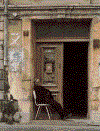
click
to enlarge

ETHNOLOGICAL MUSEUM - THE HOUSE OF CHATZIGEORGAKIS KORNESIOS
(22) 302447
Patriarchou Gregoriou 20, near the Archbishopric
Monday - Friday: 08.00-14.00 Saturday: 09.00-13.00
It is an important 18th century building in Lefkosia which after being
restored, won the 1988 Europa Nostra Award. Once the residence of the Dragoman
Chatizeorgakis Kornesios, it now houses the Cyprus Ethnological Museum and is furnished in
period style.

FAMAGUSTA GATE - NICOSIA MUNICIPAL CULTURAL CENTER
(22) 430877
Leoforos Athinon
Monday - Friday: 10.00-13.00 16.00-19.00 (17.00-20.00 June-August)
The Venetian walls which completely encircle the old city have a circumference
of 4.5 km and possess eleven heart-shaped bastions. There were only three gates into the
city in the north, south and east. One of these gates, the Porta Giulana called Famagusta
Gate, has been restored and is now the Lefkosia Cultural Center. The vaulted passage and
two side rooms are used for exhibitions, conferences, lectures and various performances,
with the passage leading to the moat.
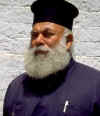

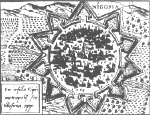
click
to enlarge

CHRYSALINIOTISSA CHURCH
Within walking distance from the Archbishopric
Considered the oldest Byzantine church in Lefkosia, it is dedicated to
‘Our Lady of the Golden Flax’ and is believed to have been built in 1450 by
Queen Helena Palaeologos but also contains fragments of an older church of the 11th of
12th century.

click
to enlarge

CHRYSSALINIOTISSA CRAFTS
CENTER
Ipponaktos and Dimonaktos
A interesting complex of eight workshops nesting around a central courtyard,
designed on the basis of a traditional Inn. It accommodates units engaged in contemporary
applications of traditional crafts including woodcarving, glass blowing,herbs and oils,etc

CYPRUS MUSEUM
(22) 302189 (See plan at the bottom of the page)
Mouseiou 1
Monday - Saturday: 09.00-17.00 Sunday: 10.00-13.00
A treasure-trove of major Cypriot archaeological and works of art dating from
the Neolithic Age to the Early Byzantine Period and gives a comprehensive view of the
history of the island
There is also an archaeological library attached
You can’t miss the huge showcase displaying terra-cotta votive statues and
figurines of the 7th and 6th centuries B.C. from the shrine of Ayia Irini excavated by the
Swedish-Cypriot expedition of 1929, this overwhelming group comprises mainly warriors,
minotaurs and charioteers - some life-size - out of the 2,000 figures only two female
statuettes were found. Notice too, the conical stone from Palea Paphos associated with
Aphrodite worship.
The museum contains some beautiful archaic and classical statues. The most
striking of them may well be limestone Head of a Woman from Arsos - an outstanding
portrait with a face both sensual and wise. Just as compelling, the small, marble
Aphrodite from Soli has a cool, classical allure. The towering bronze statue of the Roman
Emperor Septimus Severus is an outstanding work of Roman-Cypriot art; and a fine example
of the self glorification of the Roman Emperors. the nude emperor strikes a pretty pose .
A fascinating group of reconstructed tombs and their original contents span the
centuries from the 3rd millennium to around 4 BC. Also of special interest are gold
objects excavated from tombs at Palea Paphos, dating from the 11th to 8th centuries BC.
A copper and bronze work exhibit reflect the importance of these metals in
ancient Cyprus, there is even a reproduction of a copper mine (room 12)

click to enlarge

OMERIYE MOSQUE (22) 302189
Near the main Municipal Market within the walled city.
Monday - Saturday: 10.00-12.30 13.30-15.30
Converted into a mosque in 1571 by Mustapha Pasha, who believed that the
original 14th century Augustinian church of St. Mary was built on the spot where prophet
Omer rested when visiting Lefkosia. Most of the original building was destroyed by Ottoman
artillery in 1570. The door of the main entrance belongs to the 14th century Lusignan
building. Remains of a later Renaissance phase of the building can be seen at the
north-eastern side of the monument. It is the only mosque in the Greek side of Nicosia
still in use as a Muslim place of worship.

PHANEROMENI CHURCH - CHURCH OF THE REVELATION
Onasagoras street, within the old city
Built in 1872 during Turkish rule this used to be the largest church in
Lefkosia. The marble mausoleum to the east of the church contains the relics of the
bishops and priests executed by the Turks in 1821 as a deterrent to the movement for Greek
independence . Attached to the church is a building housing the Phanaromeni library, which
has the oldest icons in Cyprus

TRYPIOTIS CHURCH
Solonos 47-49, near Laiki Yiltonia
Built by Archbishop Germanos II in 1695, it is an interesting example of the
Franco-Byzantine style.
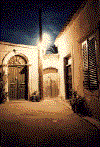
click
to enlarge
LAIKI YITONIA
Pedestrian area within the walled city, east of Plateia Eleftherias.
Charming winding alleys with traditional houses, shops, restaurants and
galleries all lovingly restored as typical examples of Cypriot urban architecture of a
bygone, more graceful age. (especially as it is sanitised)
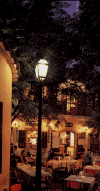
click
to enlarge

STATE GALLERY OF CONTEMPORARY ART
(22) 302951
Leoforos Stasinou and Kritis
Monday - Friday: 10.00-17.00 Saturday: 10.00-13.00
Representative collection of paintings and sculptures by 20th century Cypriot
artists.

ST. PAUL’S ANGLICAN CATHEDRAL
(22) 442241
Leoforos Lordou Vyronos
This parish church built for Anglican residents was built in 1893 in a style
reminiscent of many English village churches.

MUNICIPAL THEATER
(22) 463028
Mouseiou, opposite Cyprus Museum
Built in neo-classical style, the theater is used for musical concerts, dance
performances and various ceremonies. It is also the main venue of the Cyprus Theater
Organization.

CYPRUS HANDICRAFT CENTER
(22) 305024
Leoforos Athalassas 186
Workshops: Monday - Friday 07.30-14.30 Thursday 15.00-18.00 Shop: Monday -
Saturday 08.00-13.00 (October-April) 14.30-17.30 (May-September) 16.00-19.00 (except Wed
& Sat afternoons)
The government-run center aims to promote and enrich the traditional folk art
and craft skills.It has various workshops and a showroom and shop at it’s premises,
as well as shops in Laiki Yitonia and in all other towns.

Since the opening up of the green line we have taken the opportunity to
flit across and explore a little. This is what we saw;
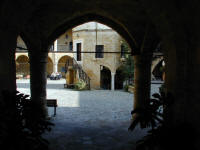
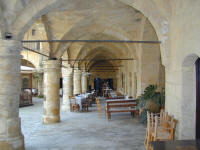
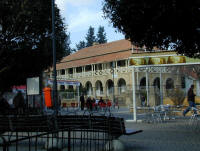
Click to enlarge There was
an airport in Nicosia once upon a time, but that was closed for commercial
use after the invasion in 1974. Now it is used by the UN and the Nicosia Dog
shelter.
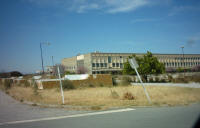
Click to enlarge
|
A
real restored house to visit

| 55
Solonos Street 

This house at no 55 Solonos street
has been lovingly restored by its present owner Mr. Nicos Ioannou.
It has a long history, the remnants of an
underground water well and hiding place, and a long tunnel leading out of the walls of
Nicosia. This served to hide the beautiful women of a well known family from
the Turks during their domination in the 1800's.
|

click
to enlarge
It later became a department of
the Samuel primary school and in the 1950's it hosted the Communist party
headquarters.
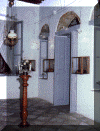
click
to enlarge
Now
after 200 years it is used to house jewellery displays by its owner who is a gifted
craftsman and can be viewed at any reasonable time or when there is an exhibition
underway.

click to enlarge
|

Click
here to reveal a map of Nicosia
 This is a plan of the Nicosia Museum
This is a plan of the Nicosia Museum
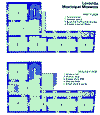 And this is a plan of the Leventis Museum
And this is a plan of the Leventis Museum

|